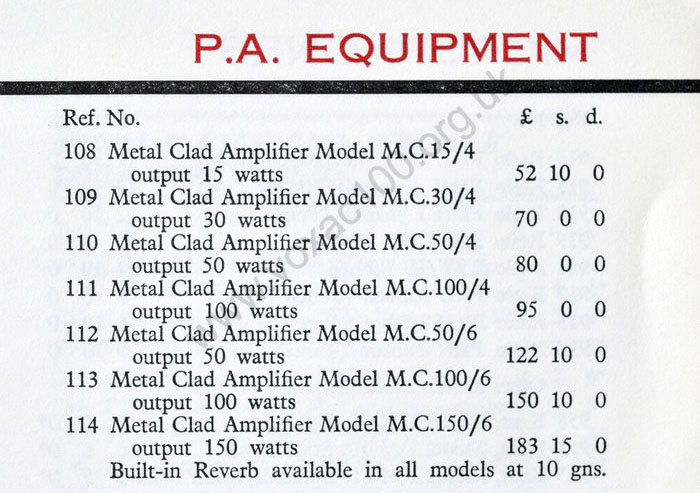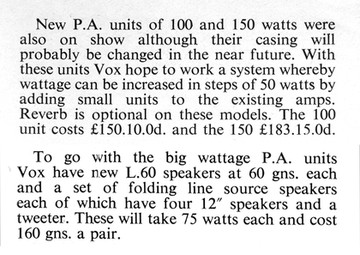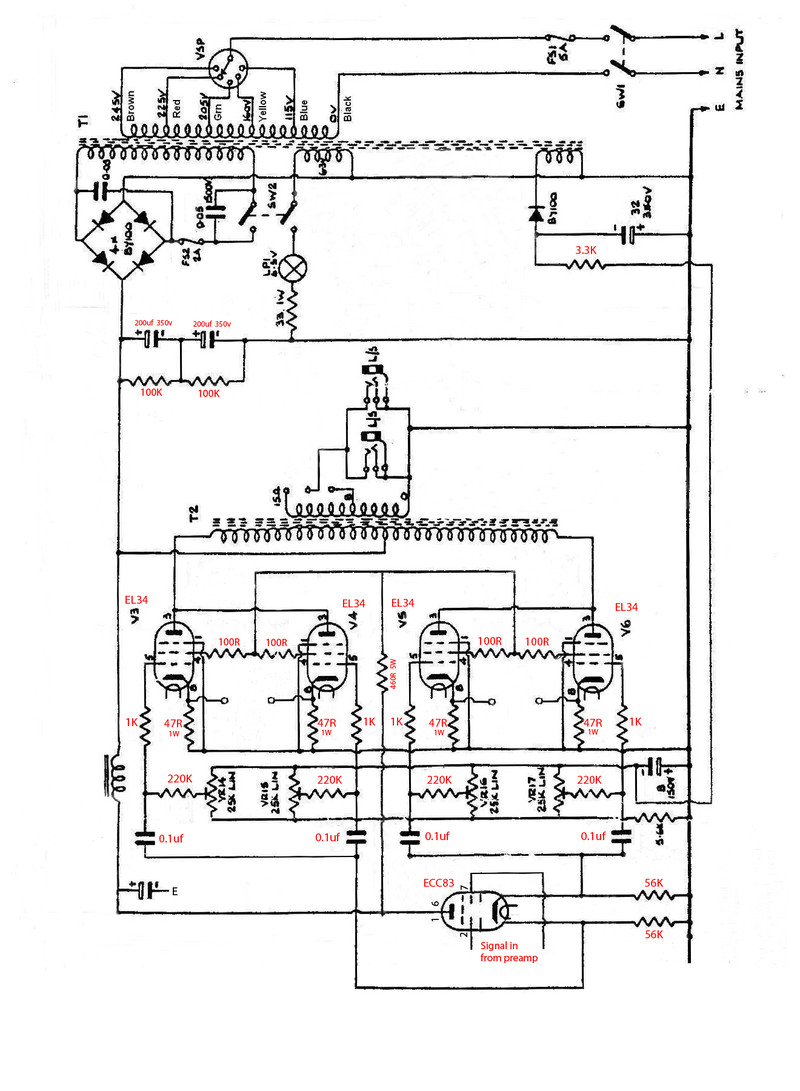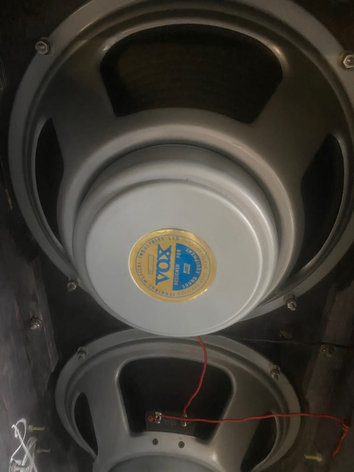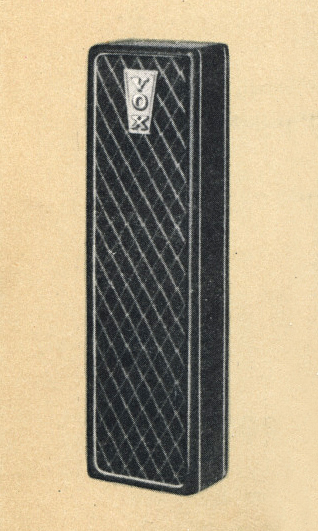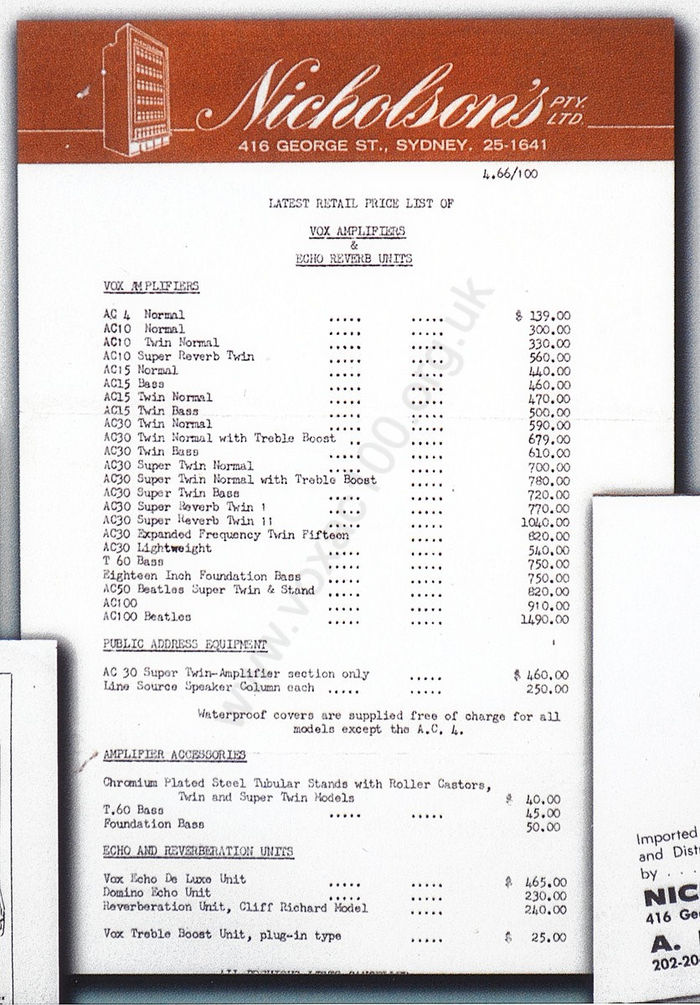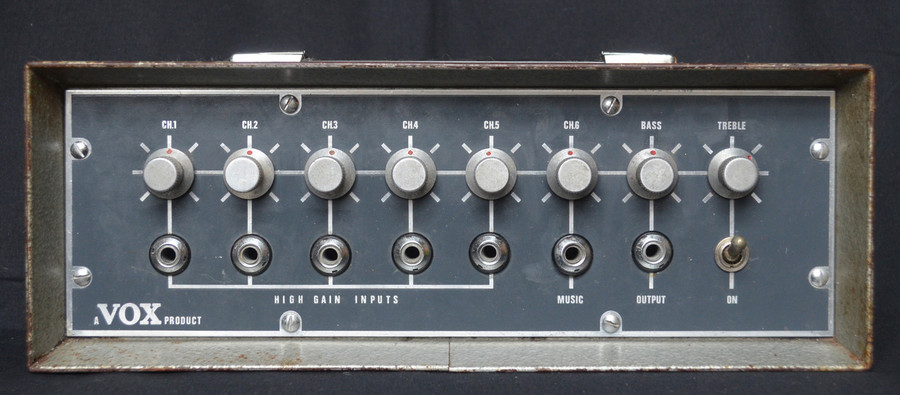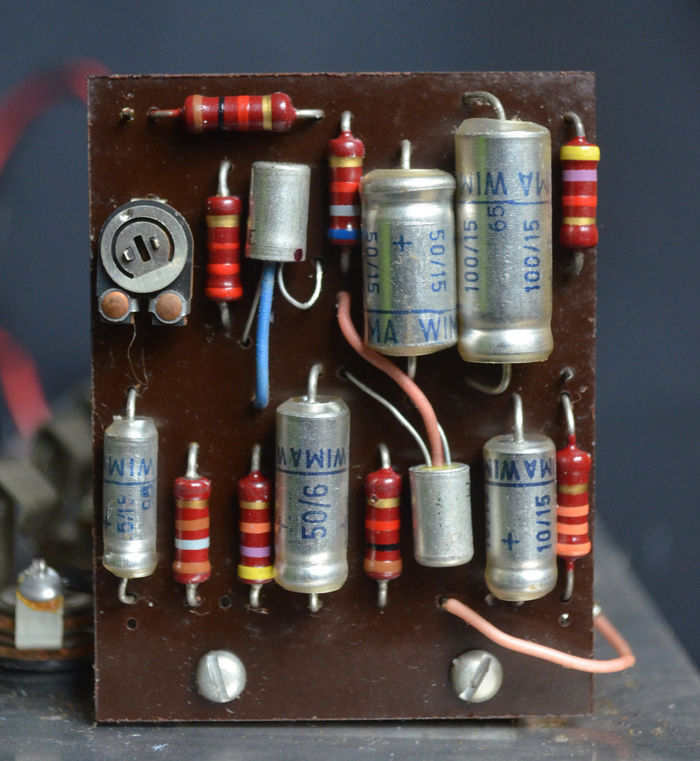VOX AC100 - UPDATES AND NEW INFO
January to April 2021
29th April
This picture has been removed from the page on the Vox Works on Dartford Road. It is a photograph, acquired by Derek Underdown, of the John Compton Organ factory in North London. See this page.
26th April
The jauntily-coloured "Tooling" magazine, July 1966. A note of the new Burndept Lab and Drawing Office set up on West Street, Erith - presumably near or possibly even in the West Street Works, which was occupied in part by Vox.
From late 1966, JMI circuit diagrams bear Royston's name and symbol, though they were normally still drawn by JMI's draughtsmen - Albert Hogben (A.E.H.) or "T.A.M." (name unknown at present).
25th April
Thanks to Henning, further pictures of AC100 serial number 2022 (chassis no. 2218):
23rd April
Further notes on the Vox Metal-Clad amplifiers. At the Russell Hotel Trade Fair in August 1964, the new "all-in-one" PA amplifier was shown. This had a built-in "Reverbalux" unit, which was advertised as a separate in the "Precision in Sound" newspaper format catalogue of late 1964. None are known to survive. It seems unlikely that many if any actually found their way to market.
Metal clads with six inputs/channels invariably have transistor preamps (MC50/6, MC100/6, MC150/6). Presumably the "Reverbalux" was transistorised too.
Although the "Reverbalux" was quietly dropped, reverb alone was offered as an option for the PA amplifiers from 1965 at 10 guineas extra:
The question is what sort of reverb? The four-input all-valve MC50/4 and MC100/4 are 14 inches wide - enough to accommodate the type of tank fitted in the portable Reverb units, but nothing larger. The circuit will probably have been the one documented in OS/075/R.
For the MC50/6, MC100/6, and MC150/6 a transistorised reverb system is likely to have been adopted - presumably along the lines of the one incorporated in the 7-series amps. The six-input Metal-Clad amplifiers are easily wide enough to take the longer tank.
The type of tank used in Vox transistorised preamps - the 7-series and later the fully solid state range. The transducers are Sonotone gramophone cartridges.
22nd April
A preliminary page on the mighty Vox MC150 public address amplifier has now been set up - available here. It will be augmented soon with pages on the modular transistor six-channel preamp, and the power section (four KT88s).
21st April
Below, a page from the journal of the "Association of Public Address Engineers" (A.P.A.E.), December 1963, recording Jennings's joining.
JMI at this time was in the process of augmenting its range of PA equipment - having already put sets of speakers into production.
Westrex, Reslo and Goodmans, with whom JMI did much business, were presumably the inspiration in this respect. All three companies had brought portable PA sets to market by 1962 at the latest.
The wireless microphone system that JMI exhibited at the 1964 Public Address exhibition - see this page - evidently did not go down particularly well.
In the edition of the journal for September '64, a long article described the innovations (and priority) of Lustraphone in the field. Lustraphone had begun work on its systems in 1962. More on this later.
Simply to add, that at least one former JMI employee is certain that the Vox system in any case was little more than a copy initially of one devised by another manufacturer: "Tiger Radio".
20th April (2)
A further image from "Guitar Magazine" (Japan), Oct. 1992 - a copper-panelled AC80/100 in a thin-edged box. The speaker cabinet is pictured with serial number 162 in a later Japanese publication.
It may be that the amp below is serial number 184, which is known to be in Japan. The arrangement of diamonds on its grille cloth does not correspond with any other brown fronted AC80/100s on this site.
20th April
A better image from "Guitar Magazine" (Japan), October 1992. The AC100 pictured has a black panel and apparently is in near mint condition. Note the link voltage selector. In other words, the amp is an AC80/100 with a serial number in the 200s.
19th April (2)
"Melody Maker" magazine, 7th October, 1967 - an intriguing small ad, though it is not clear how the 15" and 18" speakers were arranged. Presumably "made to match" indicates that grille cloth was consistent between the elements, but possibly not Vox diamonds.
19th April
A page coming shortly on the Vox MC150, the big beast of the metal-clad Public Address amplifier range (150 watts). Introduced in the autumn of 1965 - in time for the Russell Hotel Trade Fair - the unit remained in production well into 1967. It was sold in Europe as well as the UK.
The larger amps in the MC line had four speaker output sockets. In the case of the MC150, one could run four LS40 column speakers (4 x 40 watts), four LS60 (4 x 60 watts), or a combination of the two. It is no coincidence that the LS60 and MC150 were both introduced in the autumn of '65.
Below, a detail of a picture taken in the Vox Works in the summer of 1969. In one of the testing rooms, on the bench, a mains transformer for a MC100. The assemblies at left belong to a solid state PA50SS.
The legend on the tape sticker reads: "MC100/6 or /4 MAINS".
16th April
Below, the pages from the Thomas Organ Accessories service manual (May 1967) relating to the six-channel Vox PA mixer.
From 1965, English-made units were fitted with different types of transistor, presumably depending on availability: RCA 2N2613 - see the example on this page, where it is used in all four positions. In other JMI mixers, one finds Mullard OC77 with OC75, and OC44 with AC107. The AC107 is an integral part of the preamps of later MC100/6s. All were low-noise germanium and expensive at the time - even more so now.
Thomas used SK3004 and SK3003/SK3005 instead. In English-made units, C1 and C12 are normally 5uf, not 2uf. Whether 2uf is reflected in the build of American mixers is not clear at present.
A copy of the JMI circuit diagram will be made available shortly.
14th April
Thanks to Juan, pictures of an AC100 owned by Carlos Zubiaga of the Mocedades. Chassis number 1777, serial number probably in the high 1100s. No metal guard around the EL34s. The amp is likely to have been produced very late 1965 / early 1966.
13th April
Below, a detail from the article "The Vox Legacy" in "Guitar Magazine" (Japan), October, 1992. The AC100 in view still has its original VOX hang tag (new style). The presence of rectangular Cannon XLR speaker sockets on the back panel indicates late-run cathode biased, or perhaps early "100W Amplifier" - serial number in the 400s or low 500s.
Also illustrated in the article is an AC80/100, thin edged box, brown grille cloth, copper control panel - perhaps serial number 184, which is known to be in Japan.
3rd April
Some more Vox dealers added to this page:
DANVILLE (Illinois) - Thomas Music.
TUSCOLA (Illinois) - Argee Music Limited.
KINSTON (North Carolina) - Johnson Piano and Organ Co.
LOGAN (Utah) - Organ Center.
SALT LAKE CITY (Utah) - Carelton-Stewart Music.
Thanks to Dan for info on Thomas Music in Danville. Further additions coming shortly.
31st March
Detail from the JMI brochure produced for the German market in March 1967. Although there is no "50" or "100" on the front of the amp pictured, it is probably a MC50/6. The MC100/6 has an indicator lamp above the mains switch. In early 1967, 1678DM and 2198DM were equivalent respectively to around £150 and £200 - substantially more than the list price in the UK.
JMI brochure printed in March 1967 for Mufag, one of the three main West German Vox distributors. "Metallverstärker", literally "Metal Amplifier" is shorthand for "Metal Clad".
29th March
Below, the information panel of the JMI circuit diagram for the MC100/4 mark 2, drawn out by Albert Hogben on 18th June 1965, i.e. shortly before the Trade Fair at the Russell Hotel in August. The revised and expanded PA range was displayed in public for the first time at the Fair with the advice that the cosmetics would be updated - more on this page.
Item from the review published in "Beat Instrumental" magazine, October 1965, of the British Musical Instrument Trade Fair at the Russell Hotel, London, August 1965.
The MC100/4 mark 1 - Metal Clad amplifiers with sloping fronts, and a few with plain metal flat fronts - were produced from mid 1964 to late 1965.
A detail of the information panel of OS/086 for the MC100/4 mark 2.
25th March
AC100 serial number 2022, sold in Germany recently. Grille cloth replaced, good external condition. Nothing known of the electronics.
23rd March
The diagram posted yesterday has been revised - the ECC83's plate supply was rendered incorrectly. Below, a schema of the underchassis connections that run to the preamp via the octal sockets. A schema of the feeds from the top of the chassis to the preamp coming soon.
23rd March
Some brief notes on the power section of the Vox MC100/6. As one might expect, in general form it is much the same as that of the MC100/4. However, in place of the ECC83 gain stage, there is an ECC83 and ECC82, the former a gain stage, the latter a phase inverter - to split the signal from the solid state preamp into two for the two pairs of EL34s. The power section also has circuitry to feed signals to the meter in the preamp: output level, and HT. The umbilicals connecting to the preamp are slightly more complex therefore than those of the all-valve MC100/4.
22nd March
Below a provisional circuit diagram of the Vox MC100/4 power section, c. 1966-1968. Voltages will be added. A diagram of the preamp and octal socket connections between the two sections is in progress.
The starting point for the sheet below was the power section of the Vox UL7120. There are of course differences. The 7120 is a choke input filter design (choke in front of the main reservoir capacitors). Its power transformer has a winding to serve the solid state preamp; and the screens of the KT88s are run differently.
But for all that, the circuits are close, especially in the arrangements made for bias adjustment and testing. Component values in the MC100 reflect the use of EL34 power valves rather than KT88s.
In terms of date of design, it looks as though the power sections of the blue/grey fronted MC50/4 and MC100/4 go back at least as far as early 1965 - i.e. to the sloping front Metal Clad public address amplifiers.
The signal from the valve preamp is passed to the ECC83 through one of the octal sockets (marked with yellow tape). The other octal socket (marked in red) links the feeds for the main power switch, the fuse, and indicator lamp.
18th March
Some notes coming soon on the circuits of the final generation of MC100 metal clad amplifiers produced by JMI - the all-valve MC100/4 and part-transistor part-valve MC100/6 in blue/grey livery. Examples can be seen on this page.
Just to say that it is now clear that their power sections are close relatives (very close indeed) of the power section created for the UL4120 and UL7120 amplifiers, but adjusted for EL34s. The two UL series amps had KT88s.
The question is whether the circuits devised for the power sections of the MC100s of 1966 descend from the MC100/4 and MC100/6 of late 1964 - in other words, whether their circuits pre-date those of the UL4120 and UL7120.
A former JMI employee has kindly provided the name of the electronics company - not Triumph, Burndept, or JMI - thought to have devised the power sections of the UL amps This will be taken up shortly.
16th March
Details of the Celestion G12S - light-weight magnet, Jennings silver/polygrey in colour - in one of a pair of Vox Line Source 60 (LS60) column speakers from 1966. The greenback version of this driver was the T1252. The pictures have been added to the page on the LS60.
13th March (2)
Material on the Vox 100 watt public address amplifiers has been updated - the MC100/4 and MC100/6 in 1964 and 1965, and from 1966 to 1968.
These are great, heavyweight amps. It may be possible soon to include an entry on and photos of an important early survivor.
13th March
The page on the later Vox 50 watt PA amps - the MC50/4 and MC50/6, 1966-1968 - has been updated. Further updates on these amps to come, but probably not for a few weeks yet. In progress, updated pages on the Vox 100 watt PA units.
12th March (2)
There is now a new page on early Vox MC50s - the Metal Clad 50 watt amplifiers produced in 1964 and 1965. This runs parallel to the one on the Vox AC50 website.
Coming shortly, a page dedicated to MC50s in the period 1966-1968 - the revised all-valve MC50/4, with four inputs, and the new hybrid MC50/6 with a transistor preamp and valve power section.
At least two circuit diagrams for these amps survive. These will be posted when they are to hand (possibly in a month's time).
12th March
The page on Vox wall / portable speakers has been updated. It seems unlikely that many units containing 8" drivers survive today - most will have been bought by clubs or factories. But a certain number of 10" and 12" cabs have survived, original Elac drivers intact.
11th March
The page on the Vox Line Source 60 column speakers, new in the autumn of 1965, is now up. Documentation relating to the Line Source range (and certain Vox Public Address amplifiers) will be assembled on a page of its own. In the later sixties, "list price" meant very little in the larger cities. A number of shops - Pan Music on Wardour Street in London being one - was able to sell new Vox gear at huge discounts.
10th March
Material relating to the Vox Line Source 40 column speakers - the LS40, re-christened the "Grenadier" in the USA from 1965 - has been updated and gathered on a new page - available here. More to come shortly. The Stones certainly had a pre-production set in late 1963 (illustrated on the page) - a search is underway for photos of other early instances.
There is now also a page, ported from the Vox AC30 website, on the Vox Metal Clad 30 public address amplifier, taking in also the MC15, its smaller brother - available here.
Material relating to the Vox Line Source 60 column speakers, 1965-1969, should be up on a new page tomorrow.
9th March
Various new pages on Vox public address equipment - with new info from former JMI employes - are on the way. Also in progress, revised pages on Vox speaker cabinets - first Line Source 15 (LS15) units. There will be an introductory page on Line Source cabinets as a "type", setting out its history, from beginnings in the UK in 1952 to the late 1960s.
Promotional picture, 1964.
Relevant shop adverts from the back pages of "Melody Maker" magazine will be incoporated next week.
8th March
Thanks to Toni, images from Derek Underdown's copy of a JMI brochure produced for the Italian market in the last third of 1964. Note that AC100 depicted is in a thick-edged box with corner protectors.
The caption effectively follows the English version released earlier in the year: "100 Watts output, Volume, treble and bass controls. Individual requirements for the soloist sometimes demand more power than is normally For adequate reverse of sheer undistorted power, the A.C.100 is unrivalled."
Detail from the JMI catalogue of 1964.
7th March
Two JMI circuit diagrams for the PA mixers have been identified - OS/058 and OS/082. When copies are to hand (it may take some weeks) they will be posted here.
Currently on ebay in Germany, AC100 serial number 2022, from 1967. The cabinet has been regrilled. Unlike serial numbers 1994 and 2036, the back boards have rounded corners, and the corner protectors are fixed with one rather than two nails. But those of course are "cosmetics". There are no pictures at present of the chassis.
28th February
The page on the Vox PA mixer from c. 1966 is now available here. Further updates coming soon. .
26th February
As a preliminary to a more extensive update on the Vox Wireless Radio (Wireless) Microphone systems, a detail from the pricelist of September 1964.
As can be seen, there were two versions - narrow band (a bandwidth of 12.5kHz), and wide band (a bandwidth of 25kHz). The narrow band version was less prone to interference. Operating frequency was licensed by the G.P.O (the General Post Office).
The development of the two systems posed various technical difficulties for Les Hills and Alan Harding. A pre-existing circuit, originally devised by another manufacturer (more on that later), proved tricky to adjust.
Units were demonstrated by Alan Harding at Pinewood Studios and Westminster Cathedral (for potential use by celebrants), but evident interest did not result in orders.
25th February
Vox pricelist of 1966 from Nicholson's in Sydney, printed by Jim Elyea. The AC100 for Bass is $910 Australian, the AC100 Super de Luxe, $1490. Some notes on the arrival of Vox equipment in Australia in 1964 have been gathered together here.
23rd February
Work on the Vox AC30 website has delayed a number of updates here, but the new material will be added soon.
Below, details from a pricelist printed for Barth Radio-Musikhaus in 1966. Barth was one of three main Vox Dealers/Agents in West Germany in the late 1960s and early 1970s. The list, among other things, contains prices for the full range of 4-series and 7-series amplifiers, including the 7120 De Luxe (two speaker cabinets).
The AC100 bass cabinet, 2x15" speakers, is DM1300, equivalent to around £118 at the time. The UK list price in early 1967 was £100.
Various types of Metal Clad (MC) PA amplifier, including the 150 watter. See the pages on the Vox PA amps.
8th February
Pics of serial number 391, a cathode biased AC80/100, ready for sale in mid 1965, now added here. The amp is pretty much a twin of serial number 392 in all respects. The two are likely to have shipped to the USA (in company with others) soon after completion.
5th February
Thanks to Jake, pictures of serial numbers 878 and 1283 (respectively late 1965 and early 1966). Also to note that serial number 406, a cathode biased, late AC80/100 from the early summer of 1965, still exists.
Serial number 878. Two-line serial number plate.
Serial number 1283. Three-line plate.
1st February
A page on a Vox solid state mixer from 1966 is on its way. The microphone preamps are based on low-noise high-quality RCA germanium 2N2613 transistors, highly sought after these days for fuzz pedals. The mic preamps of Vox 100 watt public address amplifiers of the same date - sometimes called mixer-amplifiers - were based around germanium AC107 transistors.
The unit below measures 14 (W) x 4 3/4 (D) x 5 (H) inches, and runs off a PP9 battery:
28th January
The page on the West Street Works at Erith will be updated again shortly with new info. from a former JMI employee.
18th January
Some new shots from the Shea Stadium concert (15th August 1965) - grabbed from the 4K video.
One of the entrances seen across the car park.
Some of the concert equipment belonging to Sounds Incorporated and The Beatles on one of the bases prior to being set up on stage. In the foreground, the copper-panelled AC80/100 belonging to Sounds Inc. In front of it, a small-box AC50. To its right, one of The Beatles' AC80/100s (thick-edged box). In the background, a brown-fronted small-box AC50, another of the Beatles' AC80/100s (thick-edged box), and the Fender amp (in its cover) belonging to Sounds Inc. Far background, glimpsed between the drum cases, the AC30 used for organ during the concert.
The amp used by John. This was the copper-panelled AC80/100 issued to Paul in late December 1963 reboxed in one of the boxes of the black-fronted amps issued to John and Paul in August 1964. See this page for Paul's amp in its original brown box.
John's amp seen from the rear. Note the arrangement of sockets on the back panel.
14th January
The pages on the two major contractors that assembled AC80/100s and AC100s for JMI - Burndept Electronics in Erith, and Westrex in North London - have been updated. Further updates to follow.
6th January
An AC100 recently sold in L.A. To judge from the choke, probably a "100W Amplifier" with a serial number in the 500s or 600s, produced in the summer of 1965. A good many were exported to the U.S.A. in late 1965.
This is the amp pictured in the previous entry, now on Reverb.
1st January
A Happy New Year! Currently on Reverb, a grey panel AC100 from 1965 or 1966-ish - externally there's not much to go on in terms of date. Piping and corner protectors appear to be new, also the feet:
Below, pictures of a bass cabinet - 2x15", double pin corner protectors - issued with a late AC100 assembled by Triumph. The Goodmans Audioms have now been replaced with the very excellent Celestion Fullback 15s. Thanks to Bill for the pictures.











